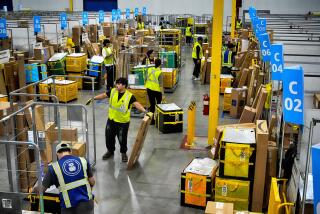U.S. growth revised down to 0.6% rate
WASHINGTON — U.S. economic growth practically sputtered to a halt in the first three months of this year, the government reported Thursday, but analysts projected a rebound was more likely than a recession.
The economy grew at an annual rate of 0.6% in the first quarter, the Commerce Department said, down sharply from 2.5% in the final three months of last year. Not since the end of 2002 had growth been more sluggish.
The latest growth figure also represented a substantial reduction from the 1.3% that the Commerce Department originally estimated a month ago, based on more preliminary data. The department will re-estimate growth one more time and issue its final figure next month.
“It’s a little unnerving,” said David Kelly, chief economic advisor for Putnam Investments in Boston. “But I think the economy is still on track.”
Kelly and other economists found encouragement in several elements of the report.
The housing sector, staggering after years of skyrocketing prices and booming construction, tumbled at an annual rate of 15.4% in the first three months of the year. Without housing’s drag, Kelly said, the economy would have grown at a respectable 3% rate -- and housing will surely make a comeback.
Another major culprit was a 0.6% decline in goods and services sold overseas. Like most analysts, Nariman Behravesh, chief economist at Global Insight in Lexington, Mass., called the export decline a fluke at a time when most major economies are growing faster than the United States’ and the weak dollar makes American products cheaper on world markets. Exports rose 10.6% in the fourth quarter.
Behravesh predicted that the export decline would probably give way to a re-estimate upward next month, or a strong rebound in the second quarter.
First-quarter growth also was held back by a drawdown in inventories as manufacturers sold more goods off their shelves instead of producing new ones.
Inventories, which rose $40 billion to $50 billion in each of the two previous years, tumbled at an annual rate of $4.5 billion in the first quarter. Inventory corrections can’t go on forever or businesses will run out of things to sell.
Encouraging signs also included upward revisions in estimates of consumer spending, which has driven economic growth for much of this decade, and even housing. Consumer spending growth was estimated at 4.4%, up from 3.8% in the preliminary data.
Housing’s 15.4% decline was not as sharp as the preliminary 17% estimate.
Inflation numbers were unchanged in the new estimates. Personal consumption expenditures, excluding food and energy, rose by 2.2%, equal to their rise in 2006 and above the Federal Reserve’s 1% to 2% “comfort zone.” That reduced already fading hopes that the Fed would cut interest rates soon to encourage more economic growth.
Many economists predicted that economic growth would rise anyway. Kelly forecast a 3% growth rate for the rest of the year. Behravesh pegged second-quarter growth at 2.5% to 3%.
Economists at Goldman Sachs said in a note to clients that the composition of the stagnation in economic growth in the first quarter “lends support to expectations of a rebound.”
A less bullish note came from High Frequency Economics, whose chief U.S. economist, Ian Shepherdson, said the economy would grow faster in the second quarter than the first, “but not by much.” He said the housing sector would contract further before straightening out.
More to Read
Inside the business of entertainment
The Wide Shot brings you news, analysis and insights on everything from streaming wars to production — and what it all means for the future.
You may occasionally receive promotional content from the Los Angeles Times.










